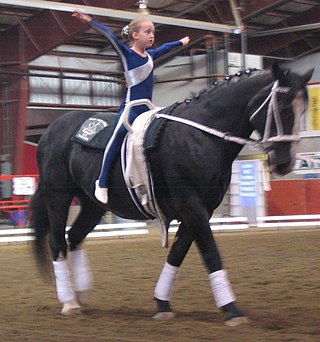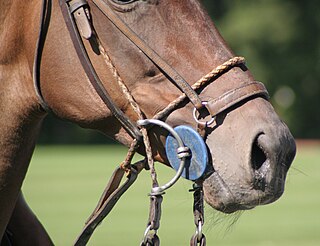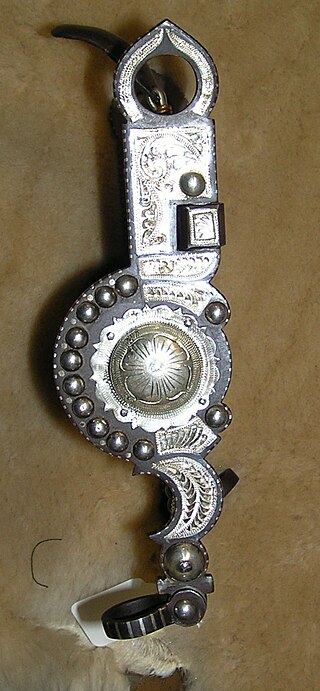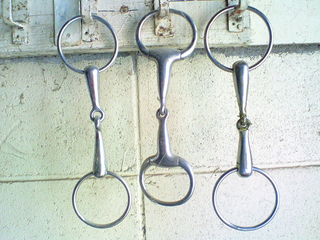Tack is equipment or accessories equipped on horses and other equines in the course of their use as domesticated animals. This equipment includes such items as saddles, stirrups, bridles, halters, reins, bits, and harnesses. Equipping a horse is often referred to as tacking up, and involves putting the tack equipment on the horse. A room to store such equipment, usually near or in a stable, is a tack room.

A bridle is a piece of equipment used to direct a horse. As defined in the Oxford English Dictionary, the "bridle" includes both the headstall that holds a bit that goes in the mouth of a horse, and the reins that are attached to the bit. It provides additional control and communication through rein pressure.

Longeing or lungeing is a technique for training and exercising horses. It is also a critical component of the sport of equestrian vaulting.

A noseband is the part of a horse's bridle that encircles the nose and jaw of the horse. In English riding, where the noseband is separately attached to its own headstall or crownpiece, held independently of the bit, it is often called a cavesson or caveson noseband. In other styles of riding, a simple noseband is sometimes attached directly to the same headstall as the bit.

A pelham bit is a type of bit used when riding a horse. It has elements of both a curb bit and a snaffle bit. In this respect a pelham bit functions similar to a double bridle, and like a double bridle it normally has "double" reins: a set of curb reins and a set of snaffle reins. Because it has a bit shank and can exert curb-style pressure on the horse, it is considered a curb bit. Like all curb bits, a pelham bit has a mouthpiece, shanks with both purchase and lever arms, a ring for rein attachment at the bottom of the shank, and a curb chain. But like a snaffle bit, a pelham bit also has a bit ring on either side of the mouthpiece. Like some curb bits, a pelham bit usually has "loose" shanks - hinged at the mouthpiece in the same way that the rings of a snaffle bit are hinged. When two sets of reins are used, the snaffle rein generally is wider, to help distinguish it from the curb. A "cowboy pelham" is a western style of loose-jawed curb bit with additional rings at the mouthpiece allowing a second set of reins to be added.

A snaffle bit is the most common type of bit used while riding horses. It consists of a bit mouthpiece with a ring on each side and acts with direct pressure. A bridle utilizing only a snaffle bit is often called a "snaffle bridle", particularly in the English riding disciplines. A bridle that carries two bits, a curb bit and a snaffle, or "bradoon", is called a double bridle.

A curb bit is a type of bit used for riding horses that uses lever action. It includes the pelham bit and the Weymouth curb along with the traditional "curb bit" used mainly by Western riders.

A double bridle, also called a full bridle or Weymouth bridle, is a bridle that has two bits and four reins. One bit is the bradoon, is a modified snaffle bit that is smaller in diameter and has smaller bit rings than a traditional snaffle, and it is adjusted so that it sits above and behind the other bit, a curb bit. Another term for this combination of curb and snaffle bit is a "bit and bradoon", where the word "bit" in this particular context refers to the curb.

Side reins are equipment used when longeing a horse, running from the bit of the bridle to the saddle or surcingle. As a horse training tool, they encourage flexion and softness in the horse's mouth. For longe line work with a rider up who does not carry ordinary riding reins, they help calm and settle the animal. However, they are a tool best used by experienced handlers; used improperly they may unduly restrict the horse's movement or cause an accident.

The gag bit is a type of bit for a horse. Because the cheek piece and reins attach to different rings there is leverage action. Severity of leverage action depends on where the reins attach. For example, in a Dutch Gag, the further the rein attachment from the mouthpiece the greater the leverage. The gag bit is related to a Pelham bit and a double bridle but the gag bit has no curb strap.
A martingale is any of several designs of tack that are used on horses to control head carriage. Martingales may be seen in a wide variety of equestrian disciplines, both riding and driving. Rules for their use vary widely; in some disciplines they are never used, others allow them for schooling but not in judged performance, and some organizations allow certain designs in competition.

The bit shank is the side piece or cheekpiece of a curb bit, part of the bridle, used when riding on horses. The bit shank allows leverage to be added to the pressure of the rider's hands on the bit. Shanks are usually made of metal, may be straight or curved, and may be decorated in some disciplines. The headstall and curb chain or curb strap of the bridle is attached to the top of the shank, and the reins are attached at the bottom. Shanked curb bits are used in western riding for nearly all adult horses, and are seen in English riding disciplines primarily as part of the double bridle used by advanced dressage riders, and on the hybrid pelham bit that includes a ring for a second rein attached at the bit mouthpiece.

A bearing rein, also known as an overcheck or a checkrein, is a piece of horse harness that runs from a point on the horse's back, over the head, to a bit. It is used to prevent the horse from lowering its head beyond a fixed point. A variation called a side check passes beside the ears through loops at the top of the bridle cheekpieces.

Draw reins and running reins are pieces of riding equipment used for training that use the mechanical advantage of a 'single movable pulley' to cause the horse to bring its head down and inward. While a regular rein is the strap that attaches to the bit and is held by the rider, these types of reins slide through the bit ring, adding leverage to the rider's hands and arms, allowing the rider to force the horse's head into a desired position.

The Gogue is a piece of horse tack used for training purposes, and is very popular in Europe, with a similar place in training regimes as side reins. Its purpose is to encourage the horse to raise the neck, free the shoulders and engage the hocks, so that he may develop the correct muscles for a rounded topline.

The bit ring is the ring on the side of a horse's bit, particularly on a snaffle bit. It is used as a point of attachment for the cheekpieces of the bridle and for the reins. It also has an effect on the action of the bit. Therefore, the design of the ring is something to consider when choosing a bit for a horse, even though the bit mouthpiece generally has a greater effect than the ring.

The bit is an item of a horse's tack. It usually refers to the assembly of components that contacts and controls the horse's mouth, and includes the shanks, rings, cheekpads and mullen, all described here below, but it also sometimes simply refers to the mullen, the piece that fits inside the horse's mouth. The mullen extends across the horse's mouth and rests on the bars, the region between the incisors and molars where there are no teeth. The bit is located on the horse's head by the headstall, and which has itself several components to allow the most comfortable adjustment of bit location and control.

The back describes the area of horse anatomy where the saddle goes, and in popular usage extends to include the loin or lumbar region behind the thoracic vertebrae that also is crucial to a horse's weight-carrying ability. These two sections of the vertebral column beginning at the withers, the start of the thoracic vertebrae, and extend to the last lumbar vertebra. Because horses are ridden by humans, the strength and structure of the horse's back is critical to the animal's usefulness.
A bitting rig or bitting harness is a training tool for horses that can teach a horse to accept a bridle and bit, and later assist a horse in developing the necessary musculature for a given equestrianism discipline. Generally used in conjunction with training on a longe line, it is most often seen in the training of Saddle seat horses, but also is used by some dressage trainers and as a tool to start horses in driving.

A bitless bridle is a general term describing a wide range of headgear for horses or other animals that controls the animal without using a bit. Direction control may also be via a noseband or cavesson, if one is used. The term hackamore is the most historically accurate word for most common forms of bitless headgear. However, some modern bitless designs of horse headgear lack the heavy noseband of a true hackamore and instead use straps that tighten around a horse's head to apply pressure in various ways. These are often specifically patented and marketed as "bitless bridles", usually referencing a particular type of headgear known as the cross-under, though other designs are sometimes also given similar names.














